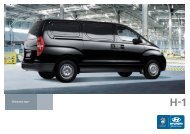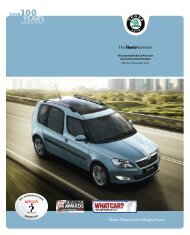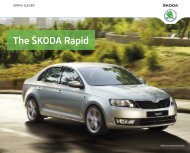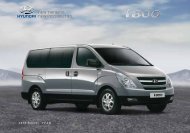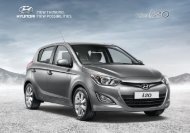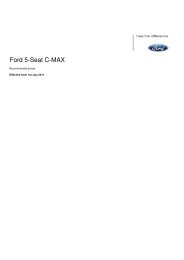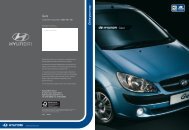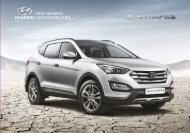Download Brochure - Howard Abraham
Download Brochure - Howard Abraham
Download Brochure - Howard Abraham
You also want an ePaper? Increase the reach of your titles
YUMPU automatically turns print PDFs into web optimized ePapers that Google loves.
Technical glossary<br />
ABS: the anti-lock braking system<br />
prevents the wheels from locking<br />
during heavy or emergency braking,<br />
enabling the vehicle to remain<br />
steerable. When braking, wheel speed<br />
sensors measure the road wheel<br />
speed and should one or more<br />
wheels start to lock the system<br />
reduces brake pressure to that wheel.<br />
Elements of the ABS System :-<br />
• Dual Rate Vacuum Brake Boosters:<br />
increases brake effort under<br />
emergency braking conditions.<br />
• EBC: Electronic brake control.<br />
The engine brake torque control<br />
regulates the power supply by<br />
intervening with the engine<br />
management system.<br />
• EBD (aka EBV): Electronic Brake<br />
Distribution automatically<br />
distributes different pressures to<br />
the front and rear brakes to stop<br />
the rear wheels from locking up<br />
under heavy braking. It also<br />
compensates for loaded and<br />
unloaded vehicles therefore doing<br />
away with the need for a Load<br />
Sensing Valve on the rear axle.<br />
• MBA Mechanical brake assist uses a<br />
mechanical device inside the brake<br />
servo. If the brake pedal is pressed<br />
rapidly , it activates the mechanical<br />
device to give maximum braking<br />
pressure to the wheels, even if the<br />
driver is not pressing the brake<br />
pedal particularly hard.<br />
CAN Bus: the CAN Bus is an<br />
electronic data bus which links the<br />
various different electronic control<br />
systems in the car. It ensures ideal<br />
co-ordination between systems and<br />
reduces the amount of wiring needed<br />
in the car.<br />
Fuel cut-out: should one or more<br />
of the airbags inflate after an<br />
accident, this system automatically<br />
cuts out the fuel supply, thus<br />
preventing subsequent leakage<br />
of the diesel or petrol.<br />
Trip Computer: the trip computer not<br />
only features an impressive range of<br />
data displays, operating it is simplicity<br />
itself. A multifunction touch key<br />
enables you to call up all relevant<br />
data on the easy-to-read display.<br />
Features include external<br />
temperature, time, current fuel<br />
consumption, average fuel<br />
consumption, miles driven and<br />
average speed.<br />
CR: the completely new range of<br />
diesel engines are built on a system<br />
of Common-Rail fuel injection. The<br />
diesel engines have a high-pressure<br />
common rail direct injection fuel<br />
system and four-valve technology.<br />
As a result, the new engines are<br />
much quieter, more refined in their<br />
operation and consume less fuel,<br />
compared to the Pump Duse engines<br />
and significantly reduce emissions.<br />
DPF: diesel particulate filter is part of<br />
the exhaust system responsible for<br />
cleaning the engine exhaust gases<br />
before they enter the atmosphere.<br />
The DPF catches soot particles<br />
emitted in the exhaust gas and it<br />
works in conjunction with the<br />
catalytic converter, which reduces the<br />
amount of harmful gases entering the<br />
atmosphere. The DPF must<br />
periodically be emptied of the soot<br />
particles, a process known as<br />
regeneration. This involves elevated<br />
exhaust system temperatures.<br />
A driving style is required during<br />
regeneration, where a constant<br />
vehicle speed above 37 mph must be<br />
maintained. This does not always suit<br />
customers who make frequent short<br />
journeys or experience stop/start<br />
driving or drive within inner-city or<br />
urban areas.<br />
ESP: electronic stability programme<br />
is designed to stabilise the dynamic<br />
handling response of the vehicle by<br />
counteracting any tendency towards<br />
oversteer or understeer. The ESP<br />
constantly compares the actual<br />
movement of the vehicle with<br />
predetermined values and according<br />
to the situation ESP reacts by braking<br />
each wheel individually (according to<br />
direction of slip) and automatically<br />
adjusting the engine’s output.<br />
Elements of ESP system:-<br />
• ASR: anti-slip regulation traction<br />
control ensures the Yeti’s stability<br />
when pulling away or accelerating.<br />
If the engine power or torque being<br />
transmitted to the drive wheels is<br />
too great, for example on a slippery<br />
road surface, engine torque is<br />
automatically reduced until optimum<br />
road holding returns, thus<br />
preventing wheelspin. A light<br />
indicates whether the ASR system is<br />
on. It can be manually switched off.<br />
• MSR: the engine torque control<br />
system recognises when the wheels<br />
are subject to too much slippage<br />
and regulates the power supply<br />
by intervening in the engine<br />
management system. This prevents<br />
wheelspin when, for example,<br />
changing down on a smooth or wet<br />
road surface. MSR is a constituent<br />
part of the ASR system.<br />
• EDL: the electronic differential lock<br />
continually compares the rpm of the<br />
drive wheels, and if it identifies a<br />
difference between them which<br />
could lead to an individual wheel<br />
spinning, for example if the two<br />
wheels are on different types of<br />
surface or accelerating on wet<br />
leaves, the system brakes the wheel<br />
affected until uniform rpm of all<br />
drive wheels is restored.<br />
• HBA: Hydraulic brake assistant<br />
increases the optimal build-up of<br />
brake power. It ensures complete<br />
use of the brake system potential,<br />
thus shortening the braking<br />
distance.<br />
• HHC: Hill hold control allows for a<br />
safe hill start by holding the brake<br />
for a small amount of time, reducing<br />
the risk of unintentional reversing or<br />
roll back.<br />
• TPM: Draws the driver’s attention to<br />
any pressure loss in any of the tyres.<br />
Early warning can prevent damage<br />
from occurring as a result of an<br />
under inflated tyre or a defect that<br />
radically changes the cars behaviour<br />
and driveability.<br />
• DSR: Driver Steering<br />
Recommendation – in a crisis<br />
situation it helps the driver stabilize<br />
a skid by making a slight<br />
intervention in the steering.<br />
• ESBS: Electronic Stability Brake<br />
System – targeted interventions in<br />
the braking process improve the<br />
handling of a car as it brakes when<br />
passing round a bend and keeps it<br />
from veering.<br />
• AFM: records and assesses all<br />
available data about the journey to<br />
optimize the ESP system’s reactions,<br />
which can thus be adapted to any<br />
driving style and the current vehicle<br />
payload.<br />
• Xenon lights: the Xenon lights<br />
produce about 2.5 times the light<br />
of standard Halogen lights with 35%<br />
less energy consumption.<br />
Calculating your tax liability<br />
To find out how much tax you will pay,<br />
simply take the P11D value, then multiply<br />
this figure by the BiK percentage. Then<br />
simply multiply this figure by 20% or 40%<br />
depending on the level of income tax that<br />
you pay.<br />
Please note if your employer provides you<br />
with free fuel, this is treated as an<br />
additional taxable benefit.<br />
For more information on company car<br />
taxation please visit the HM revenue and<br />
customs website www.hmrc.gov.uk<br />
26<br />
BiK calculation example- Yeti S GreenLine II 1.6 TDI CR 105PS DPF<br />
P11D value £16,990.00<br />
Company Car BiK tax based on CO2 emission level 13%<br />
Taxable BiK (for 2011/2012 tax year): 13% of £16,810.00 £2,208.70<br />
Annual company car tax (2011/12)<br />
20% Income Tax: 20% of £2,208.70 £441.74<br />
40% income Tax: 40% of £2,208.70 £883.48<br />
Monthly company car tax (2011/12)<br />
20% Income Tax: £441.74 divide by 12 months £36.81<br />
40% income Tax: £883.48 divide by 12 months £73.62



